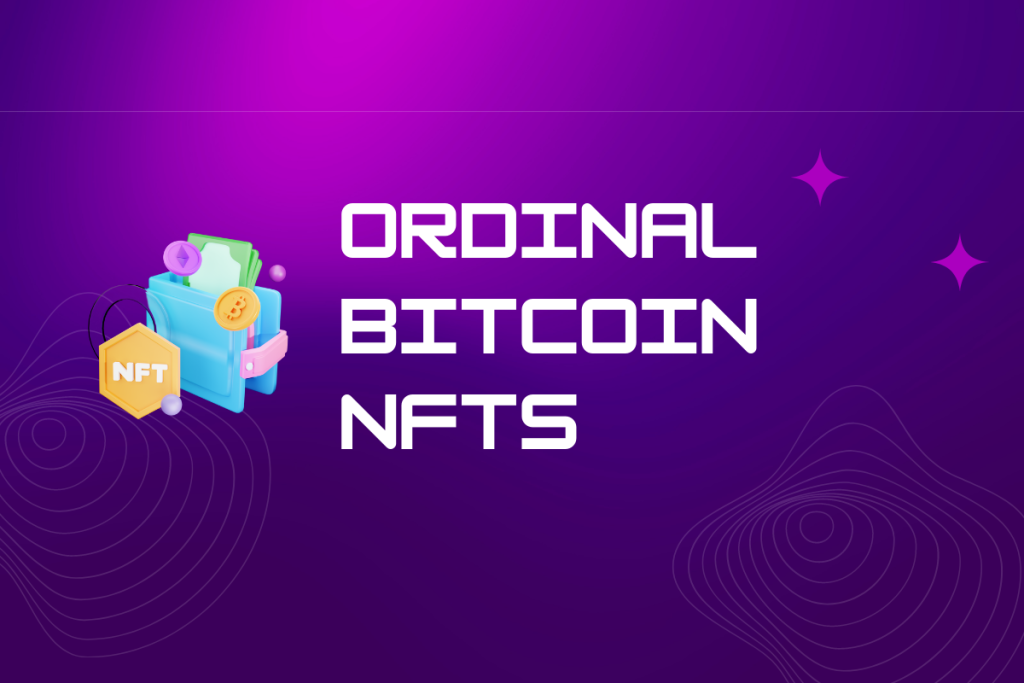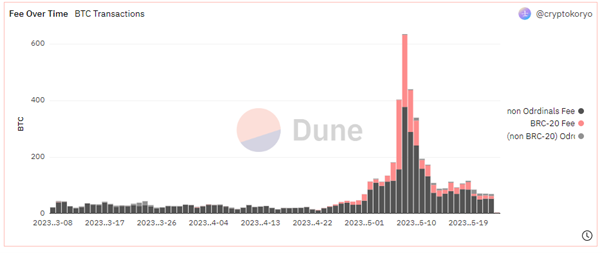Step into a world where art and cryptocurrency collide, creating a captivating fusion that pushes the boundaries of creativity. In this article, we dive into the fascinating realm of Ordinal Bitcoin NFTs, where pixels and code intertwine to redefine digital art on the legendary Bitcoin blockchain.
Discover the origins of Ordinal Bitcoin NFTs and how they distinguish themselves from NFTs on other blockchains. Uncover the impact of these unique creations on transaction fees, shedding light on the surge in commission costs within the Bitcoin ecosystem. And of course, we guide you to the vibrant marketplaces where these extraordinary digital artifacts can be acquired and exchanged.
Join us on an exhilarating exploration as we unlock the artistic side of Bitcoin, where technology meets imagination and opens doors to endless possibilities. Brace yourself for a journey that will inspire, enlighten, and ignite your passion for the world of Ordinal Bitcoin NFTs.
You may also be interested:
10 Creative DApp Examples Across Different Industries From Gaming to Healthcare

Table of Contents
When and How Did Ordinal Bitcoin NFTs Emerge?
In January 2023, Ordinal Bitcoin NFTs were introduced to the world. These unique tokens (BRC 20) were created by software developer Casey Rodarmor and have attracted the interest of artists, collectors, and cryptocurrency enthusiasts. By utilizing the Bitcoin blockchain, Ordinal Bitcoin NFTs brought a fresh perspective to the world of non-fungible tokens.
While NFTs had already gained popularity on blockchains like Ethereum, Solana, and BNB Chain, the integration of NFTs on Bitcoin was a groundbreaking development. It was made possible by leveraging the inherent capabilities of the Bitcoin blockchain and the advancements brought by the Segregated Witness (SegWit) and Taproot updates.
These updates, implemented in 2017 and 2021 respectively, expanded the Bitcoin protocol’s capacity to handle arbitrary data and store additional information within transactions. It inadvertently laid the foundation for Ordinal Bitcoin NFTs, allowing for the attachment of images, videos, and various forms of media directly to individual satoshis, the smallest units of Bitcoin.
Contrasting Features that Differentiate Ordinal Bitcoin NFTs
Ordinal Bitcoin NFTs possess distinct features that set them apart from NFTs on other blockchains. Here are some key differentiators:
- Bitcoin Native: Unlike NFTs on other blockchains that require separate layers or protocols, Ordinal Bitcoin NFTs are entirely Bitcoin-native. They reside directly on the Bitcoin blockchain without the need for additional layers, making them part of the core infrastructure.
- Backward Compatibility: Ordinal Bitcoin NFTs maintain backward compatibility with the existing Bitcoin network. This means they can coexist alongside traditional Bitcoin transactions and do not require significant modifications to the Bitcoin protocol.
- Unique Numbering System: The fundamental innovation of Ordinal Bitcoin NFTs lies in their unique numbering system. Each individual satoshi is assigned a distinct number based on its order of creation and subsequent transaction history. This numbering system, based on ordinal theory, provides a stable identifier for the data attached to sats.
- Integration of Metadata: Ordinal Bitcoin NFTs leverage the witness data section of Bitcoin transactions to hold metadata. The desired information, such as images, text, or other arbitrary data, is inscribed within this section. This differs from other NFTs, where metadata is typically stored separately or within the smart contract itself.
These contrasting features highlight the novel approach of Ordinal Bitcoin NFTs, combining the immutable and decentralized nature of the Bitcoin blockchain with the artistic expression and uniqueness of non-fungible tokens.
Discover the captivating world of Top NFT designers! Dive into our article now and be inspired by their groundbreaking creations. Don’t miss out on the chance to explore the forefront of digital art.
Understanding the Impact on Transaction Fees
With the emergence of Ordinals, the Bitcoin blockchain witnessed a notable increase in transaction fees, causing a surge in commission costs. This phenomenon can be attributed to the growing demand for block space driven by the creation and trading of BTC NFTs.
As artists and collectors flocked to explore the artistic potential of Ordinal Bitcoin NFTs, transactions involving these unique digital artifacts began to compete with regular Bitcoin transactions for inclusion in blocks. The limited block space available in each block created a supply-demand imbalance, leading to higher transaction fees as users competed to have their transactions prioritized by miners.

Factors Contributing to the Increased Transaction Fees
Several factors have contributed to the increased transaction fees on the Bitcoin blockchain following the advent of BTC NFTs:
- Block Space Competition: The limited block space on the Bitcoin blockchain means that only a certain number of transactions can be included in each block. As Ordinal Bitcoin NFTs gained popularity, they began to occupy a significant portion of the available block space, reducing the capacity for other transactions and leading to increased competition and higher fees.
- Size of NFT Data: Ordinal Bitcoin NFTs often involve the attachment of multimedia data, such as images or videos, to individual satoshis. This additional data increases the size of the transactions, requiring more space within blocks. The larger the transaction size, the higher the fees required to incentivize miners to include them in blocks.
- Network Congestion: The increased activity surrounding BTC NFTs, coupled with regular Bitcoin transactions, has resulted in network congestion. When the demand for block space exceeds the available capacity, transactions face delays in confirmation and higher fees are necessary to entice miners to prioritize them.
It is important to note that the impact on transaction fees is not solely attributed to Ordinal Bitcoin NFTs but rather the overall network activity and demand for block space. BTC NFTs have played a significant role in driving this increased demand, but other factors such as general transaction volume and the Bitcoin halving event can also contribute to fee fluctuations.
As the Bitcoin ecosystem continues to evolve, developers and the community are actively exploring solutions to mitigate transaction fee increases, improve scalability, and optimize the allocation of block space. These efforts aim to strike a balance between artistic expression through Ordinal Bitcoin NFTs and maintaining an efficient and accessible network for all Bitcoin users.
Platforms Where Bitcoin NFTs Can Be Traded
When it comes to trading Bitcoin NFTs, there are several prominent marketplaces where collectors and enthusiasts can engage in buying and selling activities. Here’s a closer look at some of the top platforms for trading Bitcoin NFTs:
- OpenSea: OpenSea is one of the oldest and largest NFT marketplaces, catering to various types of NFTs, including art, music, photography, trading cards, and virtual worlds. While it primarily operates on Ethereum, it also supports Solana and USDC. OpenSea charges a fee of 2.5% per transaction, and users need to pay gas fees for Ethereum transactions.
- Rarible: Rarible is a marketplace that allows users to buy and sell art, collectibles, video game assets, and NFTs. It accepts Ethereum, Flow, and Tezos as payment options. Rarible charges a flat 2.5% fee per transaction, along with any associated gas fees. Notably, Rarible has introduced its native token called RARI, allowing token holders to participate in decision-making processes.
- WazirX: WazirX is a centralized Indian cryptocurrency exchange that ventured into the NFT market with its dedicated marketplace. It has gained popularity for hosting regional and traditional creators, and it works on the Binance Smart Chain network. WazirX charges a 5% service fee, and creators retain the majority of the proceedings. The platform offers an easy-to-use interface and leverages the advantages of the Binance Smart Chain, such as faster transactions and lower gas fees.
Key Considerations for Buyers and Sellers in the Bitcoin NFT Market
When participating in the Bitcoin NFT market, there are a few important factors to consider:
- Platform Compatibility: Ensure that the NFT marketplace you choose supports Bitcoin-based NFTs. While many platforms primarily operate on Ethereum, some have expanded to accommodate other blockchains, including Bitcoin.
- Transaction Costs: Take into account the fees associated with each platform, including transaction fees and gas fees (if applicable). Consider the impact of these costs on your budget and potential returns.
- Community and Reach: Evaluate the size and vibrancy of the community on each platform. A larger user base can offer more opportunities for buying, selling, and engaging with other collectors.
- User Experience: Consider the user-friendliness and ease of navigation of the platform. A smooth and intuitive interface can enhance your overall trading experience.
- Security and Authenticity: Look for platforms that prioritize security measures and provide mechanisms to verify the authenticity of NFTs. This ensures a safe and trustworthy trading environment.
By carefully considering these factors, buyers and sellers can make informed decisions about the Bitcoin NFT marketplace that best aligns with their needs and preferences.
Conclusion
In the mesmerizing realm where art merges with the power of cryptocurrency, we have embarked on a thrilling exploration of Ordinal Bitcoin NFTs.
Ordinal Bitcoin NFTs have revolutionized the way we perceive art, redefining its value and enabling artists to unleash their imagination like never before. These unique digital artifacts have breathed life into the Bitcoin blockchain, transforming it into a vibrant gallery where every satoshi holds a story and every transaction becomes a testament to artistic brilliance.
So, what are you waiting for? Immerse yourself in this captivating fusion of art and technology. Unleash your inner curator, collector, or creator. Dive into the limitless possibilities of Ordinal Bitcoin NFTs and let your passion for art soar.
Share your thoughts, insights, and experiences in the comments below. Join the conversation and connect with fellow enthusiasts who are pushing the boundaries of creativity in this awe-inspiring landscape.

An experienced leader in software engineering and technology, I’ve driven value for top-tier Fortune 100 and 500 clients as the former CTO of Big Drop Inc. Overseeing a global team, we secured 34 global awards for pioneering web design using our proprietary tech. As the Co-Founder of Motion Design School, I created an innovative platform for global artists. Now, I apply my expertise to the dynamic world of blockchain, leveraging years of experience to shape decentralized technology’s future.